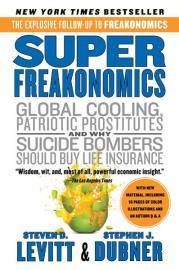Since time immemorial and all over the world, men have wanted more sex than they could get for free. So what inevitably emerges is a supply of women who, for the right price, are willing to satisfy this demand.
- Steven D. Levitt and Stephen J. Dubner
 I first heard of Freakonomics and its sequel several years ago, but because my stack of reading material is always much too high I never took the time to pick up a copy of either. My interest began to ramp up two years ago when Satoshi Kanazawa mentioned SuperFreakonomics in the column which served to introduce us when I replied to it; his follow-up column which discussed our correspondence sent an absolutely tremendous amount of traffic my way (I still get hits from it every week), so I became much more interested in the books and would probably have eventually bought them myself had Ted not sent them to me the following November. Being a stickler for doing things the right way, I read Freakonomics first and reviewed it one year ago today; the fact that it has taken me this long to get around to reviewing the sequel is due in part to my reading many other books in the interim, in part to not having nearly as much time to read as I might like, and in part to my just finally catching up from the holiday backlog.
I first heard of Freakonomics and its sequel several years ago, but because my stack of reading material is always much too high I never took the time to pick up a copy of either. My interest began to ramp up two years ago when Satoshi Kanazawa mentioned SuperFreakonomics in the column which served to introduce us when I replied to it; his follow-up column which discussed our correspondence sent an absolutely tremendous amount of traffic my way (I still get hits from it every week), so I became much more interested in the books and would probably have eventually bought them myself had Ted not sent them to me the following November. Being a stickler for doing things the right way, I read Freakonomics first and reviewed it one year ago today; the fact that it has taken me this long to get around to reviewing the sequel is due in part to my reading many other books in the interim, in part to not having nearly as much time to read as I might like, and in part to my just finally catching up from the holiday backlog.
The books were written by economist Steven D. Levitt (of the University of Chicago) and journalist Stephen J. Dubner (formerly of The New York Times); Levitt is interested in economics in its larger sense, the study of how human beings react to incentives, and Dubner makes Levitt’s investigations interesting to read. As in the first book, they covered a number of subjects: the chapters are entitled, “How is a Street Prostitute Like a Department-Store Santa?”, “Why Should Suicide Bombers Buy Life Insurance?”, “Unbelievable Stories About Apathy and Altruism”, “The Fix is In – and It’s Cheap and Simple”, and “What Do Al Gore and Mount Pinatubo Have in Common?” There is also an epilogue named “Monkeys are People Too”, which I’ve already discussed in a previous column. And though chapters two through five are fascinating, enlightening and well worth the time of anyone who’s interested in psychology, sociology, criminology and/or global warming, the first chapter provides so much material that I’m going to dedicate the rest of this column to it.
For some reason I’ve never been able to adequately fathom, economists tend to be remarkably stupid about prostitution, often abandoning skepticism and proper data-gathering to embrace ludicrous claims they would never accept about any other economic activity. Furthermore, virtually all books written about prostitution by sympathetic outsiders have a mixture of correct and incorrect information, and this one is no exception; however, I’m pleased to say that they got more right than they did wrong, and that none of the errors are due to buying into moronic prohibitionist myths. In fact, the chapter serves as a thorough refutation of the most damaging and pervasive sex work myth of our times: the notion that most whores are (or ever have been) coerced. Though the book was published in 2009 the words “sex trafficking” do not appear anywhere in it, and prohibitionist laws are correctly framed as a product of the social purity era: “The white slavery problem turned out to be a wild exaggeration. The reality was perhaps scarier: rather than being forced into prostitution, women were choosing it for themselves.” They demonstrate that about 2% of American women in the 1910s were prostitutes (already considerably lower than the 19th century average of 5.5%) and that the average Chicago whore of the period made almost twelve times as much as a factory worker. Furthermore, they clearly understand a principle I’ve pointed out before: the reason there are far fewer whores now, and the reason we make relatively less than we used to, is that so many women are giving it away now that the market simply won’t bear the prices and volume it used to a century ago.
 Unlike his more credulous colleagues, Levitt recognizes harlotry as an economic activity like any other, governed by the same laws and responding to the same pressures. In order to demonstrate this, he and Dubner look at two types of sex worker: opportunistic (and sometimes seasonal) street workers on Chicago’s south side, and a high-end escort named Allie in a different part of the same city. But while the information on escorting is sound because it was provided by Allie herself (who contacted Levitt upon hearing he was interested in writing about the subject), the information about streetwalkers was collected by a man I’ve written about before: Sudhir Venkatesh, the Columbia sociologist known for his incredible credulity, his sloppy scholarship and his ethics violations. Some of the conclusions the authors draw from Venkatesh’s data seem reasonable, such as the claim that many streetwalkers prefer to work with pimps because they bring in better clients (resulting in higher income even after the pimp’s 25% cut). Others seem highly doubtful, such as the declaration that going without a condom only costs $2 more on average; in New York, he claimed it was typically 25% more (and as I pointed out then it’s difficult to fix a “usual” price on desperation). But since there’s absolutely no way to tell the good data from the bad, nor to determine whether Venkatesh’s numbers are merely distorted or outright lies on his part (or that of the women her surveyed), this section of the chapter is absolutely worthless, and that includes the credible and highly-publicized “finding” that 3% of all tricks were freebies given to cops to avoid arrest.
Unlike his more credulous colleagues, Levitt recognizes harlotry as an economic activity like any other, governed by the same laws and responding to the same pressures. In order to demonstrate this, he and Dubner look at two types of sex worker: opportunistic (and sometimes seasonal) street workers on Chicago’s south side, and a high-end escort named Allie in a different part of the same city. But while the information on escorting is sound because it was provided by Allie herself (who contacted Levitt upon hearing he was interested in writing about the subject), the information about streetwalkers was collected by a man I’ve written about before: Sudhir Venkatesh, the Columbia sociologist known for his incredible credulity, his sloppy scholarship and his ethics violations. Some of the conclusions the authors draw from Venkatesh’s data seem reasonable, such as the claim that many streetwalkers prefer to work with pimps because they bring in better clients (resulting in higher income even after the pimp’s 25% cut). Others seem highly doubtful, such as the declaration that going without a condom only costs $2 more on average; in New York, he claimed it was typically 25% more (and as I pointed out then it’s difficult to fix a “usual” price on desperation). But since there’s absolutely no way to tell the good data from the bad, nor to determine whether Venkatesh’s numbers are merely distorted or outright lies on his part (or that of the women her surveyed), this section of the chapter is absolutely worthless, and that includes the credible and highly-publicized “finding” that 3% of all tricks were freebies given to cops to avoid arrest.
The Venkatesh streetwalker study is definitely the weakest part of the book, though as I stated above it’s impossible to tell how wrong his numbers are. My only other quibble is a minor but important one; it represents a flaw in Dubner’s thinking which is common even among sex workers, but which must be dispelled if there’s ever to be any progress. Though Allie recognizes that she is no less a whore than any streetwalker, Dubner writes “she has less in common with that kind of woman than she does with a trophy wife…she isn’t really selling sex, or at least not sex alone…” The error, of course, is that sex is purely a physical activity; Allie is very much selling sex, she’s just selling a richer sexual and sensual experience than the streetwalker is. We wouldn’t claim that a dinner theater was fundamentally different from a hot-dog stand merely because the food is better and it comes with a lot of extras; the trophy wife is a whore as well, and though it’s true that a high-end escort is closer to her than to the streetwalker, it doesn’t change the fact that all of them are whores, and that no bright, clear line can be drawn at any point on that spectrum.
